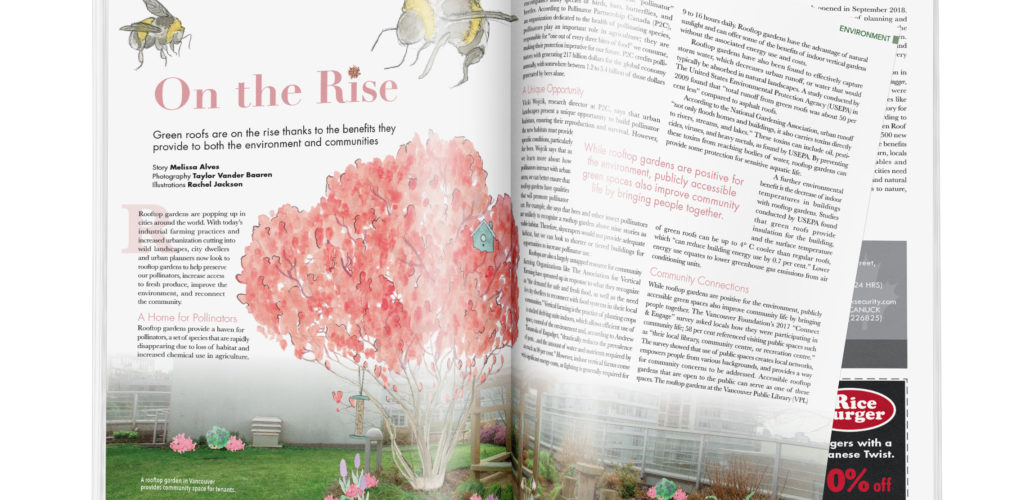This was a section feature published in the 2019 issue of Pacific Rim Magazine about the growing trend of urban and rooftop gardens. Published online here.
Originally, the piece felt a bit statistic and fact-heavy at feature length. I worked with the writer to substantively edit the story from 1800 to 870 words to focus on the most significant and compelling environmental benefits. As the theme of the issue was “Community Matters,” I also ensured that we highlighted the community impact of this trend.
Rooftop gardens are popping up in cities around the world. With today’s industrial farming practices and increased urbanization cutting into wild landscapes, city dwellers and urban planners now look to rooftop gardens to help preserve our pollinators, increase access to fresh produce, improve the environment, and reconnect the community.
A Home for Pollinators
Rooftop gardens provide a haven for pollinators, a set of species that are rapidly disappearing due to loss of habitat and increased chemical use in agriculture. While bees are the most well-known, the term “pollinator” encompasses many species of birds, bats, butterflies, and beetles. According to Pollinator Partnership Canada (P2C), an organization dedicated to the health of pollinating species, pollinators play an important role in agriculture; they are responsible for “one out of every three bites of food” we consume, making their protection imperative for our future. P2C credits pollinators with generating 217 billion dollars for the global economy annually, with somewhere between 1.2 to 5.4 billion of those dollars generated by bees alone.
A Unique Opportunity
Vicki Wojcik, research director at P2C, says that urban landscapes present a unique opportunity to build pollinator habitats, ensuring their reproduction and survival. However, the new habitats must provide specific conditions, particularly for bees. Wojcik says that as we learn more about how pollinators interact with urban areas, we can better ensure that rooftop gardens have qualities that will promote pollinator use. For example, she says that bees and other insect pollinators are unlikely to recognize a rooftop garden above nine stories as viable habitat. Therefore, skyscrapers would not provide adequate habitat, but we can look to shorter or tiered buildings for opportunities to increase pollinator use.
Rooftops are also a largely untapped resource for community farming. Organizations like The Association for Vertical Farming have sprouted up in response to what they recognize as “the demand for safe and fresh food, as well as the need for city dwellers to reconnect with food systems in their local communities.” Vertical farming is the practice of planting crops in stacked shelving units indoors, which allows efficient use of space, control of the environment and, according to Andrew Tarantola of Engadget, “drastically reduces the prevalence of pests…and the amount of water and nutrients required by as much as 90 per cent.” However, indoor vertical farms come with significant energy costs, as lighting is generally required for 9 to 16 hours daily. Rooftop gardens have the advantage of natural sunlight and can offer some of the benefits of indoor vertical gardens without the associated energy use and costs.
Rooftop gardens have also been found to effectively capture storm water, which decreases urban runoff, or water that would typically be absorbed in natural landscapes. A study conducted by The United States Environmental Protection Agency (USEPA) in 2009 found that “total runoff from green roofs was about 50 per cent less” compared to asphalt roofs.
According to the National Gardening Association, urban runoff “not only floods homes and buildings, it also carries toxins directly to rivers, streams, and lakes.” These toxins can include oil, pesticides, viruses, and heavy metals, as found by USEPA. By preventing these toxins from reaching bodies of water, rooftop gardens can provide some protection for sensitive aquatic life.
A further environmental benefit is the decrease of indoor temperatures in buildings with rooftop gardens. Studies conducted by USEPA found that green roofs provide insulation for the building, and the surface temperature of green roofs can be up to 4° C cooler than regular roofs, which “can reduce building energy use by 0.7 per cent.” Lower energy use equates to lower greenhouse gas emissions from air conditioning units.
Community Connections
While rooftop gardens are positive for the environment, publicly accessible green spaces also improve community life by bringing people together. The Vancouver Foundation’s 2017 “Connect & Engage” survey asked locals how they were participating in community life; 58 per cent referenced visiting public spaces such as “their local library, community centre, or recreation centre.” The survey showed that use of public spaces creates local networks, empowers people from various backgrounds, and provides a way for community concerns to be addressed. Accessible rooftop gardens that are open to the public can serve as one of these spaces. The rooftop gardens at the Vancouver Public Library (VPL) Central branch opened in September 2018. Carol Nelson, the director of planning and communications at the VPL, says that the community has embraced the new garden. She says it is “providing [access to] the kind of space that one usually only finds in very exclusive environments, like a hotel.”
Green roofs are beginning to catch on in cities. According to Roberta Cruger of Treehugger, 3.1 million square feet of green roofs were installed in the US in 2008 alone. Cities like Toronto have made green roofs mandatory for new building developments, and according to Will Koblensky of the Torontoist, the Green Roof by-law has resulted in the creation of 500 new green roofs. Pollinators are reaping the benefits of their new urban habitats and, in turn, locals are gaining access to fresh vegetables and herbs. These gardens are just what cities need to bridge the gap between urban and natural environments, reconnect residents to nature, and protect our future.
